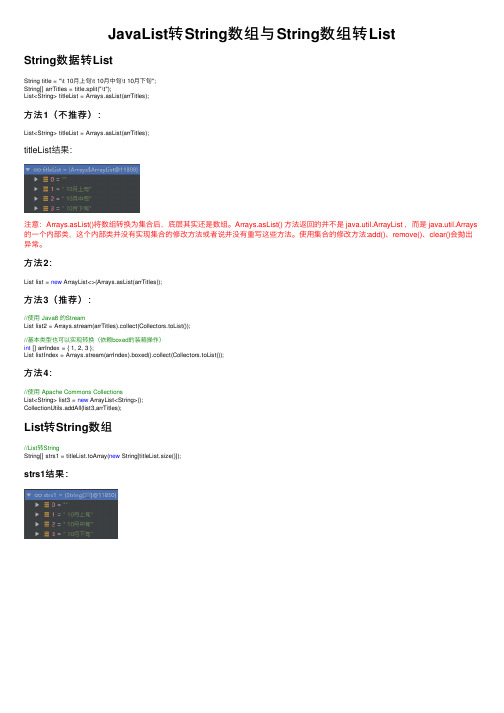JAVA数组与List之间相互转换的方法详解
java8list转map,list集合中的元素的属性转set,list集合中对象的属性转。。。

java8list转map,list集合中的元素的属性转set,list集合中对象的属性转。
⼀.使⽤java8对list操作 1.1list转map1private Map<String, Member> getMemberMap() {2 List<Member> members = mberMapper.selectMemberList(new Member());3if(CollectionUtils.isEmpty(members)){4return null;5 }6return members.stream().collect(Collectors.toMap(Member::getPhone, m -> m, (k1, k2) -> k1)); /** 去重策略,如果有多个相同的key,保留第⼀个*/7 } 1.2list中对象字段转⼀个list集合1 public static List<String> getStudentNameList(List<Student> list ){2 List<String> result = list.stream().map(student->student.getName()).collect(Collectors.toList());3for (String name : result) {4 System.out.println("name:"+name);5 }6return result;7 } 1.3list中对象字段转⼀个set集合 public static Set<String> getStudentNameSet(List<Student> list ){Set<String> result = list.stream().map(student->student.getName()).collect(Collectors.toSet());for (String name : result) {System.out.println("name:"+name);}return result;} 1.4 list 多字段排序,第⼀个字段降序,第⼆个字段升序1public static void main(String[] args) {2 List<SysUserOnline> sysUserOnlines1= new ArrayList<>();3 String date = DateUtils.getDate();4 Date date1 = DateUtils.parseDate(date);5 System.out.println("date1===="+ date1.toString());6 SysUserOnline s1 = new SysUserOnline();7 s1.setDateAlloCount(3);8 s1.setLastAccessTime(date1);9 SysUserOnline s2 = new SysUserOnline();10 s2.setDateAlloCount(1);11 s2.setLastAccessTime(DateUtils.addDays(date1,-1));12 SysUserOnline s3 = new SysUserOnline();13 s3.setDateAlloCount(2);14 s3.setLastAccessTime(date1);15 SysUserOnline s4 = new SysUserOnline();16 s4.setDateAlloCount(2);17 s4.setLastAccessTime(DateUtils.addDays(date1,1));18 sysUserOnlines1.add(s1);19 sysUserOnlines1.add(s2);20 sysUserOnlines1.add(s3);21 sysUserOnlines1.add(s4);2223 System.out.println(sysUserOnlines1.toString());24 List<SysUserOnline> collect = sysUserOnlines1.stream().sorted(paring(SysUserOnline::getLastAccessTime).reversed().thenComparing(SysUserOnline::getDateAlloCount)).collect(Collectors.toList()25 System.out.println("=======================");26 System.out.println(collect.toString());27 }1.5list分组,根据id分组1//List 以ID分组 Map<Integer,List<Apple>>2 Map<Integer, List<Apple>> groupBy = appleList.stream().collect(Collectors.groupingBy(Apple::getId));34 System.err.println("groupBy:"+groupBy);5 {1=[Apple{id=1, name='苹果1', money=3.25, num=10}, Apple{id=1, name='苹果2', money=1.35, num=20}], 2=[Apple{id=2, name='⾹蕉', money=2.89, num=30}], 3=[Apple{id=3, name='荔枝', money=9.99, num=40}]}参照:1.6list根据条件去重过滤List<ResourceHighFile> highFiles = new ArrayList<>();Set<ResourceHighFile> set = new TreeSet<ResourceHighFile>((file1, file2) -> file1.getFileName().compareTo(file2.getFileName()));set.addAll(highFiles);//根据getName去重personList = personList.stream().collect(Collectors.collectingAndThen(Collectors.toCollection(() -> new TreeSet<>(paring(Person::getName))), ArrayList::new));1.7list去除空元素list.removeAll(Collections.singleton(null));。
java lambda list转数组

java lambda list转数组Java Lambda表达式是Java 8中新增的一项特性,它基于Java函数式编程的思想,可以简化对集合数据的操作。
很多开发者在使用Lambda表达式时遇到的一个问题就是如何将List集合转换为数组。
在这篇文章中,我们将详细介绍Java Lambda表达式如何将List集合转换为数组。
一、List集合转换为数组的概述在开发过程中,我们经常需要将List集合转换为数组,以满足不同的需求。
Java 8中提供了Lambda表达式,可以更加简洁、高效的处理集合中的元素。
相比于传统方式,Lambda表达式更加易于编写和维护,也更加符合Java 8中函数式编程的思想。
二、传统方式实现List集合转换为数组在Java 8之前,我们通常使用传统的方式实现List 集合转换为数组。
具体实现方式如下:``` List<String> list = new ArrayList<>(); list.add("Java"); list.add("C++");list.add("Python");String[] array = list.toArray(newString[list.size()]); ```上述代码中,我们首先创建一个List集合,并向其中添加三个字符串元素。
接下来,我们调用List类中的toArray()方法,将List集合转换为数组并存储到array 数组中。
需要注意的是,在toArray()方法中,我们需要传递一个类型为T[]的参数,该参数指定数组的类型。
三、Java Lambda表达式实现List集合转换为数组Java Lambda表达式是Java 8中新增的一项特性,它可以更加简洁、高效的处理集合中的元素。
在Java Lambda 表达式中,我们可以使用Lambda表达式实现List集合转换为数组。
数组转为list的几种方法

数组转为list的几种方法数组转为列表(List)是编程中常见的操作,常见的实现方法有以下几种:1. 使用循环逐个添加元素这是最基本的实现方式。
可以使用for循环遍历数组,并逐个将元素添加到列表中。
示例代码如下:```pythonarray = [1, 2, 3, 4, 5]list1 = []for element in array:list1.append(element)print(list1)```2. 使用列表生成式(List Comprehension)列表生成式是一种简洁的方式,可以直接通过一行代码将数组转为列表。
示例代码如下:```pythonarray = [1, 2, 3, 4, 5]list2 = [element for element in array]print(list2)```3. 使用内置函数list()Python内置的list()函数可以接受一个可迭代对象(如数组),并返回一个列表。
示例代码如下:```pythonarray = [1, 2, 3, 4, 5]list3 = list(array)4. 使用numpy库的tolist()方法如果数组是使用numpy库创建的,可以使用tolist()方法将其转为列表。
示例代码如下:```pythonimport numpy as nparray = np.array([1, 2, 3, 4, 5])list4 = array.tolist()print(list4)```5. 使用extend()方法extend()方法可以将一个可迭代对象中的元素逐个添加到列表中。
可以先创建一个空列表,再通过extend()方法将数组的元素添加到列表中。
示例代码如下:```pythonarray = [1, 2, 3, 4, 5]list5 = []list5.extend(array)print(list5)```6. 使用map()函数和lambda表达式map()函数可以将一个函数应用到一个可迭代对象的每个元素上,并返回一个结果列表。
java8快速实现List转数组JsonArraymap分组过滤等操作

java8快速实现List转数组JsonArraymap分组过滤等操作Java 8 引入了许多方便的方法来处理集合,其中包括将 List 转换为数组、处理 JsonArray、对集合进行分组和过滤等操作。
下面将介绍如何快速实现这些操作。
1. List 转数组在 Java 8 中,可以使用 List 接口的 `toArray(T[] a)` 方法将List 转换为数组。
例如,假设有一个包含整数的 List:```javaList<Integer> numbers = new ArrayList<>(;numbers.add(1);numbers.add(2);numbers.add(3);Integer[] arr = numbers.toArray(new Integer[numbers.size(]);```2. 处理 JsonArray对于处理 JsonArray,可以使用 Java 8 提供的 Json 模块。
首先,需要添加以下依赖至 pom.xml 文件:```xml<dependency><groupId>javax.json</groupId><artifactId>javax.json-api</artifactId><version>1.1.4</version></dependency><dependency><groupId>org.glassfish</groupId><artifactId>javax.json</artifactId><version>1.1.4</version></dependency>```然后,可以通过以下方式处理 JsonArray:```javaString jsonStr = "[{\"name\":\"John\", \"age\":25}, {\"name\":\"Jane\", \"age\":30}]";JsonReader jsonReader = Json.createReader(new StringReader(jsonStr));JsonArray jsonArray = jsonReader.readArray(;for (JsonObject jsonObject :jsonArray.getValuesAs(JsonObject.class))String name = jsonObject.getString("name");int age = jsonObject.getInt("age");System.out.println("Name: " + name + ", Age: " + age);```上述代码将输出:```Name: John, Age: 25Name: Jane, Age: 30```3.对集合进行分组在 Java 8 中,可以使用 `Collectors.groupingBy` 方法对集合进行分组。
JavaList转String数组与String数组转List

JavaList转String数组与String数组转ListString数据转ListString title = "\t 10⽉上旬\t 10⽉中旬\t 10⽉下旬";String[] arrTitles = title.split("\t");List<String> titleList = Arrays.asList(arrTitles);⽅法1(不推荐):List<String> titleList = Arrays.asList(arrTitles);titleList结果:注意:Arrays.asList()将数组转换为集合后,底层其实还是数组。
Arrays.asList() ⽅法返回的并不是 java.util.ArrayList ,⽽是 java.util.Arrays 的⼀个内部类,这个内部类并没有实现集合的修改⽅法或者说并没有重写这些⽅法。
使⽤集合的修改⽅法:add()、remove()、clear()会抛出异常。
⽅法2:List list = new ArrayList<>(Arrays.asList(arrTitles));⽅法3(推荐)://使⽤ Java8 的StreamList list2 = Arrays.stream(arrTitles).collect(Collectors.toList());//基本类型也可以实现转换(依赖boxed的装箱操作)int [] arrIndex = { 1, 2, 3 };List listIndex = Arrays.stream(arrIndex).boxed().collect(Collectors.toList());⽅法4://使⽤ Apache Commons CollectionsList<String> list3 = new ArrayList<String>();CollectionUtils.addAll(list3,arrTitles);List转String数组//List转StringString[] strs1 = titleList.toArray(new String[titleList.size()]);strs1结果:。
java list对象转数组方法

java list对象转数组方法Java中List对象转数组有多种方法,可以根据实际需求选择合适的方法进行转换。
下面将介绍List对象转换为数组的几种常见方法。
方法一:使用toArray()方法List提供了一个toArray()方法,用于将List对象转换为数组。
该方法返回一个包含List中所有元素的数组。
具体使用方式如下:```javaList<String> list = new ArrayList<>();list.add("hello");list.add("world");String[] array = list.toArray(new String[list.size()]);```在这个例子中,我们首先创建了一个空的ArrayList对象,并往其中添加了两个元素。
然后,我们通过toArray()方法将ArrayList转换为字符串数组。
在toArray()方法中,我们传入了一个指定大小的空数组作为参数。
这个空数组的作用是告诉toArray()方法要创建一个与之相同类型的新数组。
如果传入的空数组大小与List大小不一致,toArray()方法会创建一个新的大小适配的数组。
方法二:使用Stream API在Java 8中引入了Stream API,它提供了一种更简洁的方式将List转换为数组。
具体使用如下:```javaList<String> list = new ArrayList<>();list.add("hello");list.add("world");String[] array = list.stream().toArray(String[]::new);```在这个例子中,我们首先创建了一个空的ArrayList对象,并往其中添加了两个元素。
java中String数组和List的互相转化

java中String数组和List的互相转化1.List转String数组⽅法⼀://先准备⼀个ListList<String> testList=new ArrayList<>();testList.add("a");testList.add("b");testList.add("c");//List转StringString[] strs1=testList.toArray(new String[testList.size()]);for(String s:strs1){System.out.println(s);}⽅法⼆://先准备⼀个ListList<String> testList=new ArrayList<>();testList.add("a");testList.add("b");testList.add("c");//List转StringString[] strs2 = new String[testList.size()];for(int i=0;i<testList.size();i++){strs2[i]=testList.get(i);}for(String s:strs2){System.out.println(s);}⼆:String数据转List⽅法⼀://准备⼀个String数组String[] strs = {"aa","bb","cc"};//String数组转ListList<String> strsToList1= Arrays.asList(strs);for(String s:strsToList1){System.out.println(s);}⽅法⼆://准备⼀个String数组String[] strs = {"aa","bb","cc"};//String数组转ListList<String> strsToList2=new ArrayList<>();Collections.addAll(strsToList2,strs);for(String s:strsToList2){System.out.println(s);}⽅法三://准备⼀个String数组String[] strs = {"aa","bb","cc"};//String数组转ListList<String> strsToList3=new ArrayList<>();for(String s:strs){strsToList3.add(s);}for(String s:strsToList3){System.out.println(s);}。
Java实现byte[]转List的示例代码
![Java实现byte[]转List的示例代码](https://img.taocdn.com/s3/m/b04aec31492fb4daa58da0116c175f0e7cd11973.png)
Java实现byte[]转List的⽰例代码⽬录前⾔Maven依赖代码补充前⾔其实这个⼯具是给⾃⼰写的,因为⾃⼰⽼是忘记。
所以记录⼀下。
Maven依赖<dependency><groupId>com.google.guava</groupId><artifactId>guava</artifactId><version>30.1.1-jre</version></dependency>代码package ai.guiji.csdn.tools;import mon.primitives.Bytes;import java.util.Arrays;import java.util.List;/** @Author 剑客阿良_ALiang @Date 2022/1/26 14:51 @Description: byte⼯具 */public class ByteUtils {/*** 字节组转list** @param bytes 字节组* @return List*/public static List<Byte> bytesToList(byte[] bytes) {return Bytes.asList(bytes);}/*** list转字节组** @param list list* @return byte[]*/public static byte[] listToBytes(List<Byte> list) {return Bytes.toArray(list);}/*** 截取bytes** @param bytes 字节组* @param from 起始位* @param to 结束位* @return bytes*/public static byte[] subBytes(byte[] bytes, int from, int to) {return Arrays.copyOfRange(bytes, from, to);}}代码说明1、主要通过guava⼯具包来实现,代码简洁。
- 1、下载文档前请自行甄别文档内容的完整性,平台不提供额外的编辑、内容补充、找答案等附加服务。
- 2、"仅部分预览"的文档,不可在线预览部分如存在完整性等问题,可反馈申请退款(可完整预览的文档不适用该条件!)。
- 3、如文档侵犯您的权益,请联系客服反馈,我们会尽快为您处理(人工客服工作时间:9:00-18:30)。
数组与List之间相互转换的方法详解
1.List转换成为数组。
(这里的List是实体是ArrayList)
调用ArrayList的toArray方法。
toArray
public T[] toArray(T[] a)返回一个按照正确的顺序包含此列表中所有元素的数组;返回数组的运行时类型就是指定数组的运行时类型。
如果列表能放入指定的数组,则返回放入此列表元素的数组。
否则,将根据指定数组的运行时类型和此列表的大小分配一个新的数组。
如果指定的数组能容纳列表并有剩余空间(即数组的元素比列表的多),那么会将数组中紧跟在集合末尾的元素设置为null。
这对确定列表的长度很有用,但只在调用方知道列表中不包含任何null 元素时才有用。
指定者:
接口Collection 中的toArray
指定者:
接口List 中的toArray
覆盖:
类AbstractCollection 中的toArray
参数:
a - 要存储列表元素的数组,如果它足够大的话;否则,它是一个为存储列表元素而分配的、具有相同运行时类型的新数组。
返回:
包含列表元素的数组。
抛出:
ArrayStoreException - 如果a 的运行时类型不是此列表中每个元素的运行时类型的超类型。
具体用法:
复制代码代码如下:
List list = new ArrayList();
list.add("1");
list.add("2");
finalint size = list.size();
String[] arr = (String[])list.toArray(new String[size]);
2.数组转换成为List
调用Arrays的asList方法.
JDK 1.4对java.util.Arrays.asList的定义,函数参数是Object[]。
所以,在1.4中asList()并不支持基本类型的数组作参数。
JDK 1.5中,java.util.Arrays.asList的定义,函数参数是Varargs, 采用了泛型实现。
同时由于autoboxing 的支持,使得可以支持对象数组以及基本类型数组。
不过在使用时,当传入基本数据类型的数组时,会出现小问题,会把传入的数组整个当作返回的List中的第一个元素,例如:
复制代码代码如下:
public static void main(String[] args){
int[] a1 = new int[]{1,2,3};
String[] a2 = new String[]{"a","b","c"};
System.out.println(Arrays.asList(a1));
System.out.println(Arrays.asList(a2));
}
1.打印结果如下:
复制代码代码如下:
1
2 [[I@dc8569]
[a, b, c]
下面说说Arrays.asList()的返回值:
JDK文档是这么说的:
public static <T> List<T>asList(T... a) 返回一个受指定数组支持的固定大小的列表。
(对返回列表的更改会“直接写”到数组。
)此方法同Collection.toArray() 一起,充当了基于数组的API 与基于collection 的API 之间的桥梁。
返回的列表是可序列化的,并且实现了RandomAccess。
此方法还提供了一个创建固定长度的列表的便捷方法,该列
复制代码代码如下:
/**
* @serial include
*/
private static class ArrayList<E>extends AbstractList<E>implements RandomAccess, java.io.Serializable {
private static final long serialVersionUID = -2764017481108945198L;
private final E[] a;
ArrayList(E[] array) {
if (array == null)
throw new NullPointerException();
a = array;
}
public int size() {
return a.length;
}
public Object[] toArray() {
return a.clone();
}
public <T> T[] toArray(T[] a) {
int size = size();
if (a.length< size)
return Arrays.copyOf(this.a, size, (Class<? extends T[]>) a.getClass());
System.arraycopy(this.a,0, a, 0, size);
if (a.length> size)
a[size] = null;
return a;
}
public E get(int index) {
return a[index];
}
public E set(int index, E element) {
E oldValue = a[index];
a[index] = element;
return oldValue;
}
public intindexOf(Object o) {
if (o == null) {
for (int i = 0; i <a.length; i++)
if (a[i] == null)
return i;
}else {
for (int i = 0; i <a.length; i++)
if (o.equals(a[i]))
return i;
}
return -1;
}
public boolean contains(Object o) {
return indexOf(o) != -1;
}
}
表被初始化为包含多个元素:List<String> stooges = Arrays.asList("Larry", "Moe", "Curly");
我们都知道,List的一个典型的特性就是其长度是可变的,我们可以很方便地对它进行插入和删除元素的操作,这是它与数组所存在的一个很大的区别,后者的长度是固定的,而且我们不能从数组中删除元素,只能修改元素的值。
利用Arrays.asList(array)将返回一个List,然而这个返回的List并不支持add和remove的操作。
这是什么原因呢?
Arrays.asList源码:
复制代码代码如下:
1
2
3 public static <T> List<T>asList(T... a) {
return new ArrayList<T>(a);
}
这里的ArrayList并不是java.util.ArrayList,而是Arrays的内部类:
我们可以看到该内部类继承的是AbstractList,下面是AbstractList的add和remove方法源码:
复制代码代码如下:
public boolean add(E e) {
add(size(), e);
return true;
}
public void add(int index, E element) {
throw new UnsupportedOperationException();
}
public E remove(int index) {
throw new UnsupportedOperationException();
}
所以,当我们对Arrays.asList返回的List进行添加或删除时将会报ng.UnsupportedOperationException 异常。
